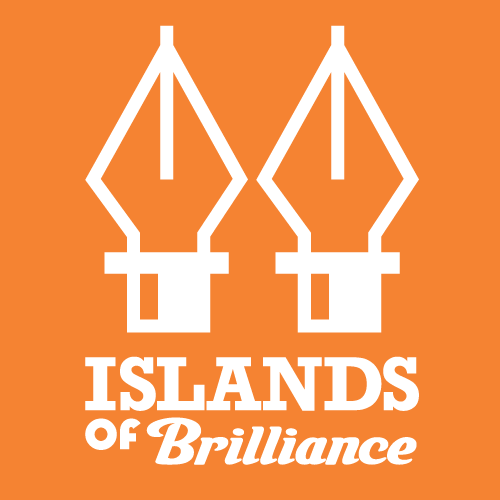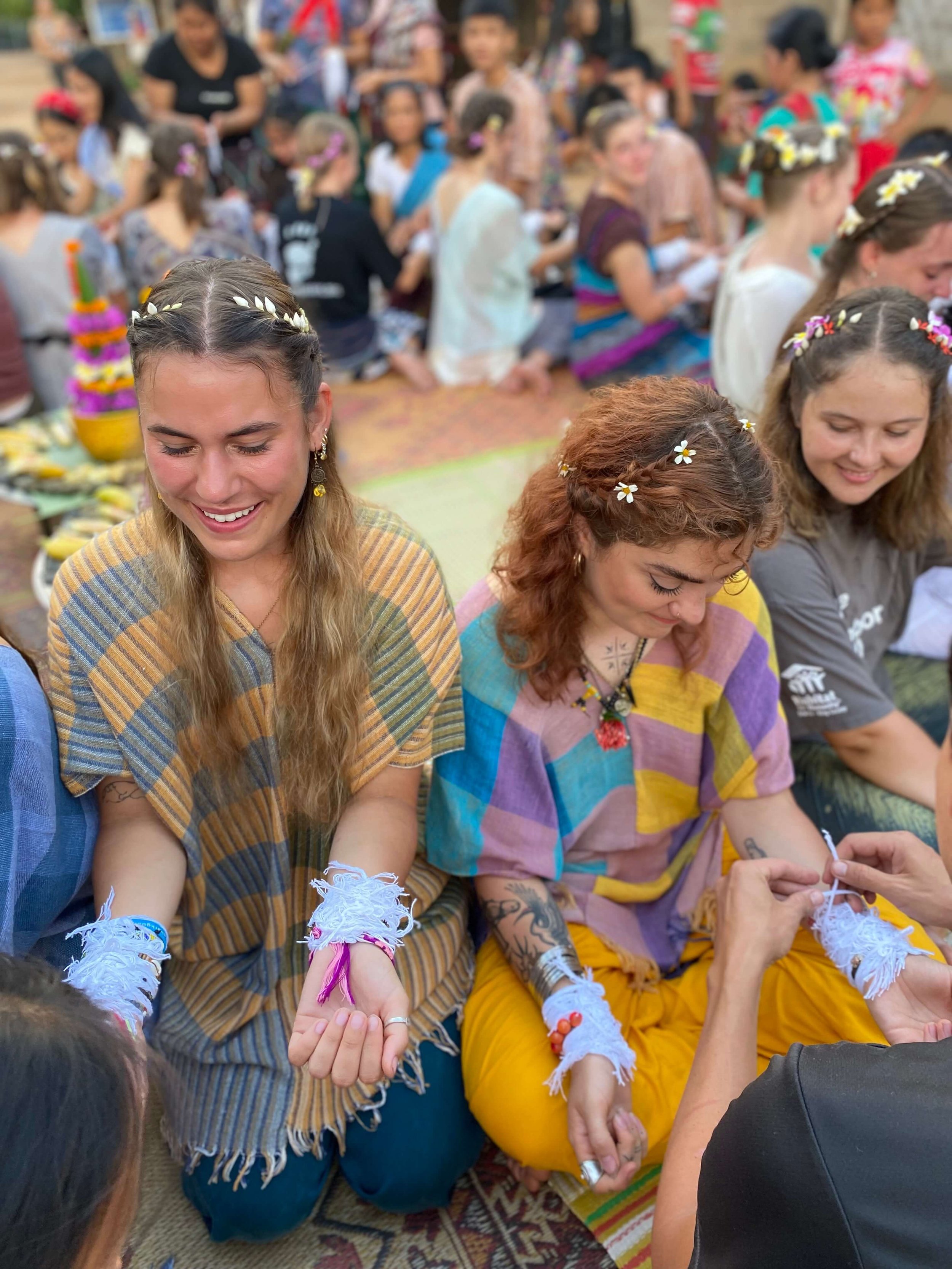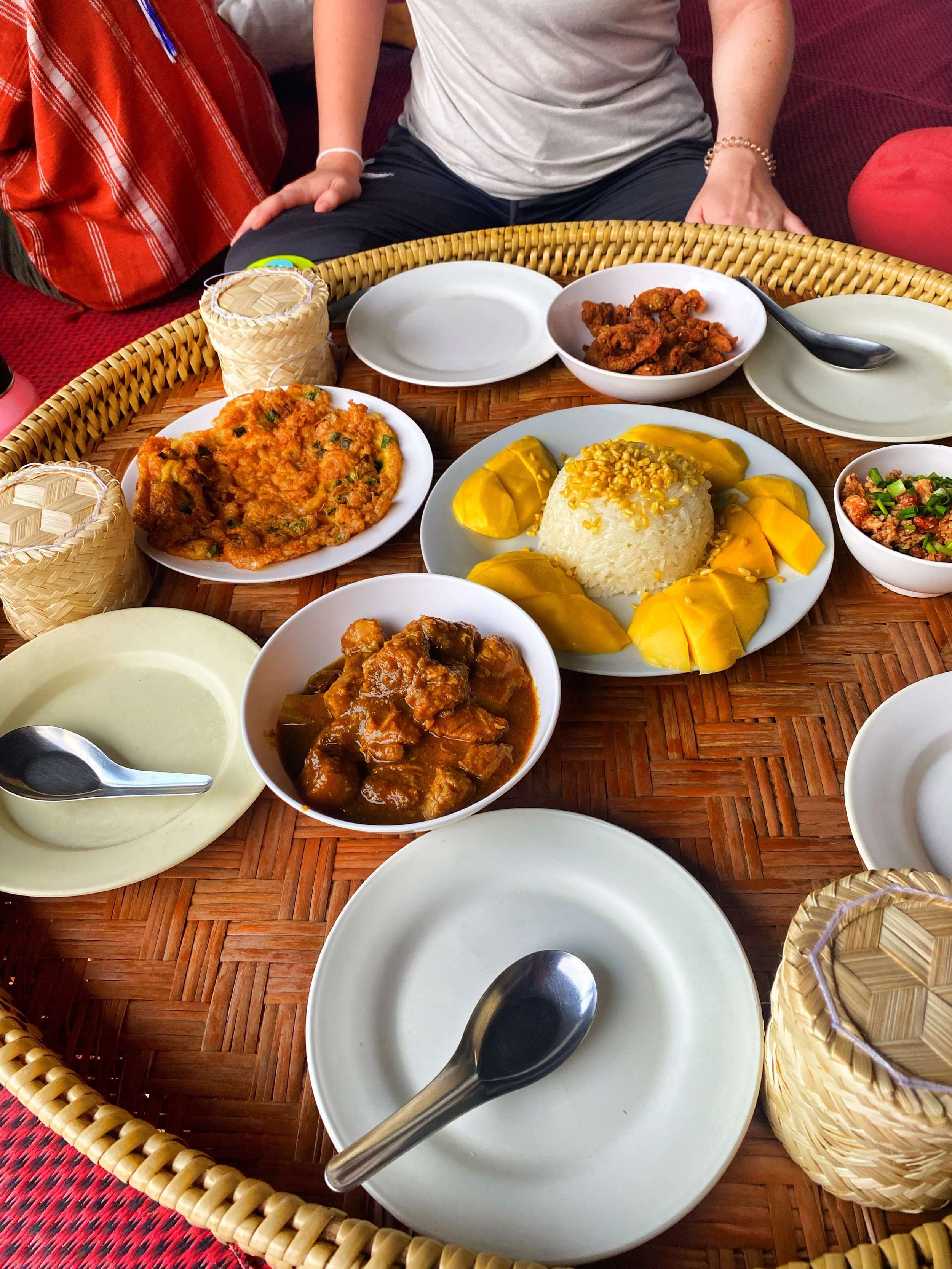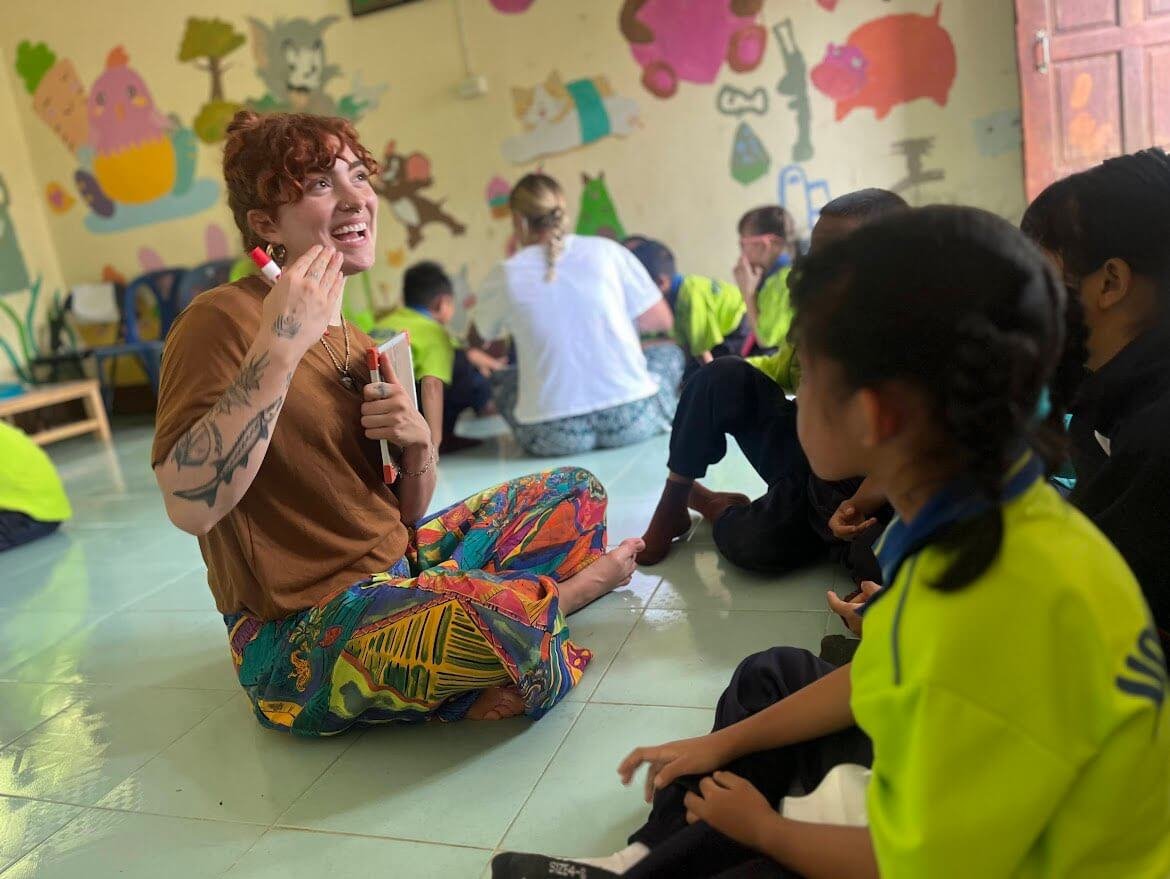There’s No Such Thing as Too Muchness
Natalie Derr recently had a life-changing experience we just had to share. Natalie has been an amazing team member with IOB since 2019. Starting as a Student Artist in Residence through UW - Milwaukee, then as a Creative Technologist after graduation. She has been instrumental in developing our Sandbox programming. Really, she jumps in wherever needed - mentoring, BBC, and a collaboration with Milwaukee College Prep that she still contributes to after the program ended.
Natalie LIVES the intersection of service and art — exploring the endless ways that art can enrich people's lives. So it did not surprise us that she took a month away from IOB to explore southeast Asia with GIVE an organization that combines travel with purposeful service. While she taught English classes and learned about local culture, farming, cuisine, and environment, she brought some perception-changing techniques developed at IOB to enrich at least one young student’s life.
We asked her some questions about the experience and how it relates to her work with IOB.
How has developing Sandbox at Islands of Brilliance impacted your self-perception as an artist and your perception of the autistic community?
First and foremost, Sandbox is a place where I, a program lead, can be myself. I once heard the phrase, “Laughter is proof of freedom,” and that you should pay attention to the places where you aren’t allowed to laugh. Like post-performance applause, laughter is your vocal chords celebrating a moment. Humor is a language frequented in Sandbox and a very important player in the planning process. From silly Smactivity prompts to dreaming up daily doodle challenges while on long walks, making breakfast, or grocery store runs, having fun in the process is a requirement for me. The whole goofy world I’m surrounded by is the inspiration. Not to mention, I can’t even count the number of times I’ve laughed in Sandbox. To be able to model my truest form of who I am to students shows them the value of authenticity. I think that when you’re in a space where you feel most comfortable being yourself, that opens the door to real interaction and genuine artmaking.
Want to be part of a daily dose of amazing? Learn more about Sandbox Daily Programming.
Perceiving yourself as an “Artist”
Speaking from experience, I think creatives can really struggle with self-perception and self-identifying as an artist. You are essentially naming yourself after the thing you create, and that in turn generates a lot of pressure to “be good” and to invite judgment of your work. I think people see art as expensive paintings in museums that you stare at for long periods of time. But that’s not even scratching the surface of what art is or what art means. I’m not here to slap a definition on what art is, but I can tell you that for me, it’s a feeling. If you’re ever curious to pose the question “What is art?” to someone, ask my passionately inquisitive coworker Chris Willey and I guarantee you won’t be disappointed with the conversation that follows. My art is the representation of how I translate the world around me. It’s how my eyes feed visual information to my brain to digest into waves of emotion, existential reckoning, and different states of mind. Art for me is getting lost for hours on a project and completely zoning into the creative and imaginative corners of my brain, abandoning any sense of where I am, what time it is, or my biological needs. The power of art is hearing a song and listening to it over and over because you’re addicted to the way it makes you feel but you can’t describe that feeling with words. Art is the thing that comes out of an experience, perspective as the product. Something I’ve come to realize that sort of breaks my brain is the fact that getting lost in the process of creating is actually the experience of being completely and utterly intact with the present moment. In an age where we hyper-fixate and romanticize the next thing or linger with heavy bones on the past thing, what a gift it is to be lost in the present moment without even realizing it.
Art builds Community through Empathy
Something I love so much about working at Islands of Brilliance is that we want to make art less intimidating and more accessible to all, so that more people feel proud to call themselves artists. Everyone deserves to, because I truly believe that the human experience we all share encompasses the purest form of art. I believe art and identity are directly linked. Let’s give people nonjudgmental spaces to create together and see how they interact with one another, what bonds form, and how their perception of their own ability changes. I’ve been in these spaces before and it is potent, passionate, and powerful. Art can create the empathy that bridges our divided roadways. Art is the way we can look around and see ourselves in other places. Have you ever spent time staring at the inside of a walnut and see how much it resembles a human brain? A sweet potato, an unlikely cousin to your pancreas. Kidney beans named after a part of your body. When looked at end-on, a carrot slice looks just like a human eye. Isn’t that crazy? We can resemble something completely different than ourselves that exists in nature.To be alive is the challenge, to live is the art.
In what ways was your IOB experience useful on this trip?
Working for Islands of Brilliance, I’ve been lucky enough to apply my personal values to my professional goals. From climbing hay bails, floating handmade boats down the creek in our yard, resuscitating shocked birds that hit the window, catching fireflies, hunting, and fishing with my dad, from childhood to the present, exploring, adventure, and curiosity are some of my most important values. There is such an incredible world waiting for us to appreciate, whether that’s admiring the lush landscape of Southeast Asia from a window seat in an airplane or blushing over the bright sunshine color of a dandelion in your backyard. (Yes, a dandelion is a flower too!) Pay more attention to the small things that serve you in your daily life, those things deserve admiration as well. The more perspectives we can observe, the more ways we can relate to the world around us. I’ve realized how important it is to use the interpersonal human experiences I’ve gained at IOB and go out into the world and apply it somewhere else.
A Month in Southeast Asia
Check out the video by Natalie’s trip-mate Kacey Dirksen
I landed back in the States on June 17th from a 28-day volunteer trip to Southeast Asia. The first two weeks in Thailand consisted of working on English education, farm-to-cafeteria, reforestation, and Asian elephant conservation projects. We also got to explore villages of the Hill tribes, bamboo rafted, ducked and crawled through extensive caves, fed and bathed elephants, and bungee jumped from a 160-foot ledge. I know right??!!!! I can’t believe I’m alive to say that. In Laos, a similar format but most of our time was spent in the remote village of Sop Chem which consisted of a 3-hour van drive and a few hours on a slow boat admiring colossal limestone mountains, quite the journey from our initial accommodation. Here the focus was on community farming, English education, and Asiatic black bear conservation. In our free time, we hiked through the jungle, swam in hidden waterfalls, meditated with monks, planted and harvested rice, learned how to make local cuisines, wove alongside incredibly gifted local women, and got a beautiful taste of what living in a remote village is like. I will never be able to describe the magnitude of significance all of these experiences had in the context of my life but I know that they are neatly organized and lovingly tucked throughout my internal being. I’m so lucky to say that this experience will live on in me and is something I get to pass down to my little ones someday.
Changing Perceptions of Disability
Natalie and Thieb
During our daily English education lessons with the local kids, I got the opportunity to work with Thieb, a ray of sunshine of the small village of Sop Chem. Whether she was splashing around in the monsoon puddles or chasing chickens around the village, you could always count on her laugh to mark her presence. Thieb is 15 years old and has a disability. When the guides handed me her lesson planning notebook, I let out a hearty chuckle seeing the notebook was IOB orange. I took this as a good omen. In the past, Thieb had been given her own lesson planning separate from the class which in turn pushed her to the back of the small classroom. I think it is important that all students are able to experience what it is like to see the front of the classroom whether that be being called up or participating with the rest of the class. So, Thieb and I’s mission was to get her out from that isolated corner and into the shared classroom environment with her peers. Once Thieb was included with the rest of her classmates in the lesson, the other students realized she was an equal part of the class. She participated when they did, she wrote when they wrote, she went up to the board to write her name when it was her turn. Thieb was always eager to cheer her classmates on, now it was time for them to return that energy for her. She was hesitant to be in front of the classroom but by the end of the week, she jumped up from her desk and eagerly skipped to the board, chalk in hand and always with a smile.
Speaking isn’t the only way to Communicate
“There are no language barriers in the afterlife” -an excerpt from Yellow Rain by Mai Der Vang
When you know you’re going somewhere where there may be a language barrier, whether that be outside of the country or even communicating with someone who is nonverbal, remember all the ways we can communicate in the absence of spoken words. There are countless ways to connect such as smiling, fist-bumping, dancing, playing a game, cooking, holding hands, teaching someone a game, arm wrestling, thumb waring, handshaking, braiding hair, giving someone a Sharpie tattoo, showing someone how to use chopsticks and laughing with them when they fail, feeding animals, watching tv, or just embracing the shared silence.
I’ve learned how to communicate in so many ways working with IOB students. What I’ve learned is that art and the creative process is a language unique to everyone, but an equalizer when done together free of judgment. Some of the best conversions I’ve had in life were doodling/crafting alongside friends and IOB participants, a little less intimidating than face-to-face conversation which can be quite intimidating for some. The act of creating is vulnerable, and being vulnerable with one another is crucial to finding commonplace in a community. More so, finding a comfortable community invites an individual to be acknowledged for who they are.
Growth and Purpose can be Found in Surprising Places
Coming back to the United States, I know I have the confidence to conquer the challenges I may have feared before this, and most importantly learning that failure is not as scary as we think it is. Failure is a gift. Being uncomfortable is the most transformative thing we can do for ourselves. We cannot learn unless we know how to navigate the absence of comfort. I realized how comfortable my life was before this, and how growth waits for us in dark spidery saves, in muddy rivers, at the bottom of your soaked hiking boot, at the tops of foggy mountains, in shared silence with a monk, the leech-infested jungle, in eating the food you’ve harvested by hand, in pronouncing Lao and Thai phrases with the wrong inflection and saying a completely different word, having the most bug bites on your legs to last an itchy lifetime, and even at the bottom of a 160-foot bungee jump. Growth is where we aren’t searching for it.
IOB has taught me that every experience in your life has a purpose. You may or may not know that purpose right away, but it will beautifully trickle in at the time you need it most.
Not all of us navigate the world the same. I think that is the thing we forget over and over about each other. We all live different truths and we all need different things. We all come from different backgrounds, with diverse limitations, some of us are outwardly good at things and some of us have hidden talents. Make that effort to find what makes people passionate. We have a variety of comfort levels, love languages, and we even hear, see, and taste things unique to only us. Ever wonder why someone out there hates your favorite food? It’s not because they choose to play devil’s advocate. People have different taste buds than your own. We show emotion in different ways, some of us wear it on our sleeves and some of us have a beautiful kaleidoscope hidden within. If all of this seems pretty rudimentary, then why do we still expect the world to adhere to our own personal standards, perceptions, and expectations? We are not each other. But that’s what is beautiful.
Did you discover any “universal truths?”
A universal truth that my teaching experiences have taught me, is that no matter where you are in the world or what language you speak, your perception of others informs their perception of themselves. Example: if you embrace someone for who they are and believe in their ability to succeed, you instill that in them. Our internal judgments can translate to our body language. If you’ve ever been around a teacher who wasn’t comfortable around you, you can see it in the way they avoid eye contact, turn their body away from you, and maybe avoid any communication at all. When someone shows you they care, they show it wholeheartedly. We are reflective creatures, so when someone is showing us kind, happy, empathetic energy, we are more likely to respond with the same. Kindness really is contagious, and it’s meant to be.
Thailand native, naturalist, and one of my guides on my trip, P-Dave, (P in front of a name in Thailand is a sign of respect to your elder, it translates as older brother or sister), reminded us regularly that one person really does have the impact to make real change in this world. He reminded us that “To the world you may be one, but to one you may be their world.” Once you open the door for inclusion, community acceptance will follow. Once you change the narrative from disability to capability, community perception shifts. When that happens, personal perception can shift. It doesn’t always follow that order, but a community can easily transform an individual.
Overall, I’ve learned that Islands of Brilliance isn’t merely a single string in my life, but a beautiful braid intertwined with my life as an artist, community member, global citizen, and working professional. It’s part of what makes up the colorful weaving that is my life and my collected experiences, and for that, I am eternally grateful.








